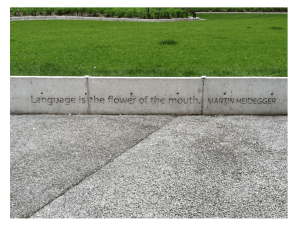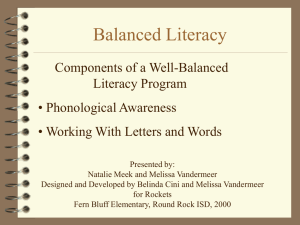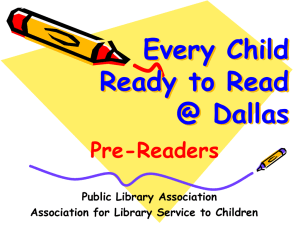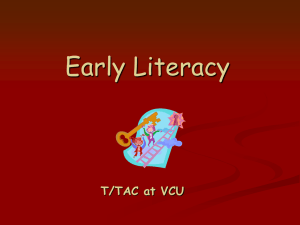4/12/16 Basic Processes that Support Successful Reading Learning Objectives
advertisement
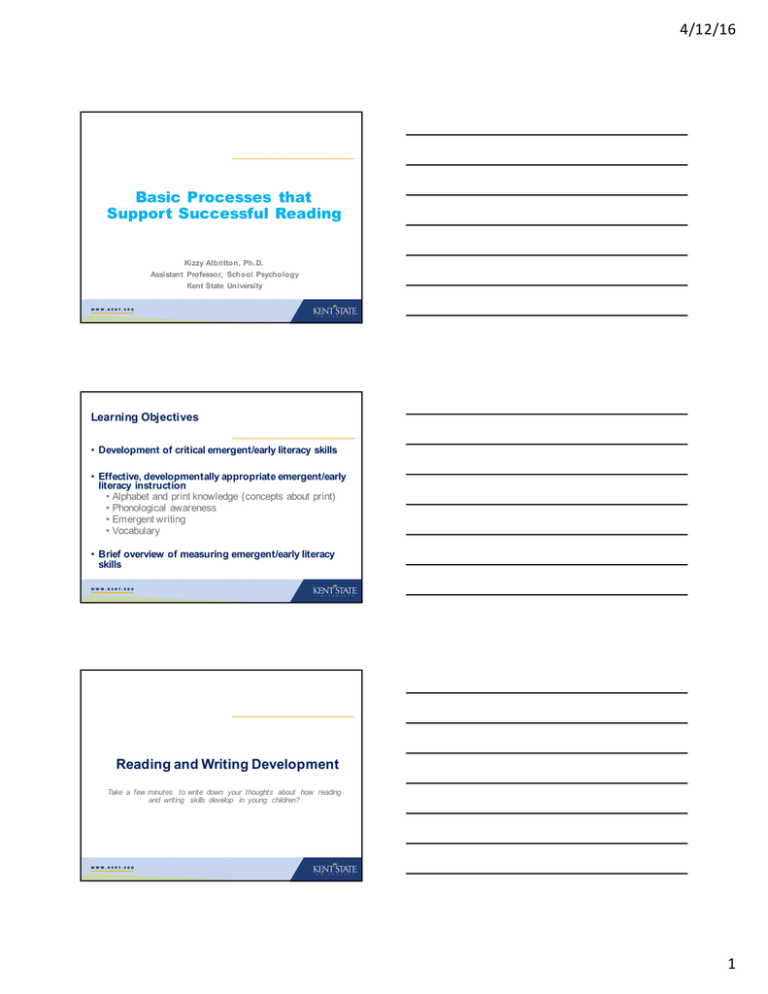
4/12/16 Basic Processes that Support Successful Reading Kizzy Albritton, Ph.D. Assistant Professor, School Psychology Kent State University Learning Objectives • Development of critical emergent/early literacy skills • Effective, developmentally appropriate emergent/early literacy instruction • Alphabet and print knowledge (concepts about print) • Phonological awareness • Emergent writing • Vocabulary • Brief overview of measuring emergent/early literacy skills Reading and Writing Development Take a few minutes to write down your thoughts about how reading and writing skills develop in young children? 1 4/12/16 Reading and Writing Development What does research tell us about how reading and writing skills develop in young children? How does literacy develop? • It is the combination of an individual’s developmental processes and language and life experiences (Glaeser et al., 2000). • Reading and writing are language-based skills. So, they develop as oral language develops. • Unlike oral language, reading and writing are relatively “new” human inventions. They are not innate. • Develops over many years from birth through adulthood, with early, emergent literacy skills developing normally before formal schooling. • Parents and family systems are the primary providers of literacy awareness, examples, and instruction. • The total act of reading and writing is affected if a student struggles with just one reading or writing skill. Two Domains of Emergent Literacy (Whitehur st & Lonigan, 1998) Contextual Units (e.g., Narrative) Semantic Units (e.g., Concepts) Language Units (e.g., Words) Sound Units (e.g., Phonemes) Outside-In Reading Inside-Out Print Units (e.g. Graphemes) 2 4/12/16 The Many Strands of Skilled Reading (Scarborough, 2001) LANGUAGE COMPREHENSION BACKGROUND KNOWLEDGE VOCABULARY KNOWLEDGE LANGUAGE STRUCTURES VERBAL REASONING SKILLED READING: fluent execution and coordination of word recognition and text comprehension. LITERACY KNOWLEDGE WORD RECOGNITION PHON. AWARENESS DECODING (and SPELLING) SIGHT RECOGNITION Reading is a multifaceted skill, gradually acquired over years of instruction and practice. What are some behavioral characteristics of skilled readers? Skilled readers: • • • • Look at most words on a page Look longer at unexpected words Pay attention to the individuals letters in words Usually unaware that they are doing this. Do skilled readers pay attention to every letter? Let’s see who can read the next paragraph without errors! 3 4/12/16 What do skilled readers do when they cannot decode a word? Think about how are you able to read this sentence: She may be an Iditerod rookie, but she’s a skookum one. (from the Anchorage Daily News, 3/18/94) (Adapted from Scarborough, (Adapted from Scarborough, 2005) 2005) What do skilled readers do when they cannot decode a word? She may be an Iditerod rookie, but she’s a skookum one. 1. Sight Recognition: all words except the red ones. 2. Decoding: • id-it-er-od?…Aha!…Eye-diterod, the dogsled race! • s-k-oo-k-u-m…skookum? 3. Use Context: • Iditerod makes sense because it’s from an Alaskan newspaper. • It says “…rookie, but…,” so “skookum” must be a good characteristic that rookies don’t ordinarily have. To recognize printed words, comprehend sentences, and learn new vocabulary items, sight recognition and decoding and contextual clues are all very helpful. Each are limited if employed alone! Areas of the Brain Used for Reading (Adapted from Haskins Labs Code Module, 2006) Research conducted by Shaywitz, Shaywitz, Pugh, Blachman, et.al. (2004) showed that with early explicit instruction, the brains of children at-risk for reading failure changed to look like the brains of non-struggling readers. 4 4/12/16 (Adapted from Scarborough, 2005) Why are beginning reading instruction & early intervention so critical? Effective, Developmentally Appropriate Emergent/Early Literacy Instruction What key skills should be the focus of early reading and writing instruction? The NRP In 1997, United States Congress National Institute of Child Health and Human Development & U.S. Department of Education Report of the National Reading Panel (2000) (Adapted from Scarborough, 2005) 5 4/12/16 National Reading Panel What were the results from the National Reading Panel (2001)? The NRP In 2002, National Institute for Literacy, National Center for Family Literacy, National Institute of Child Health and Human Development, U.S. Department of Education, & Office of Head Start Report of the National Early Literacy Panel (2008) National Early Literacy Panel What were the results from the National Early Literacy Panel (2008)? 6 4/12/16 Best Predictors of Reading Success LANGUAGE COMPREHENSION BACKGROUND KNOWLEDGE Expressive Vocabulary VOCABULARY KNOWLEDGE LANGUAGE STRUCTURES Sentence/Story Recall VERBAL REASONING Print / Book Concepts LITERACY KNOWLEDGE WORD RECOGNITION Phonolog. Awareness PHON. AWARENESS DECODING (and SPELLING) Letter Knowledge SIGHT RECOGNITION (Adapted from Scarborough, 2005) Effective, Developmentally Appropriate Early Reading and Writing Instruction When should we expect these key skills to develop? How do children demonstrate this knowledge? Grade/ Ages Stages of Reading Development Pre-K Pre-alphabetic 0-6yrs Chall Stage 0 1 st -2 nd gr Early-Alphabetic 6-7yrs Chall Stage 1 2 nd-3 rd gr Mature Alphabetic 7-8yrs Chall Stage 2 4 t h-6 t h gr Orthographic 9-11yr Chall Stages 2-3 Characteristics Learn print concepts; recognize letters in name and environmental print; use pictographic writing; emergent phonological awareness; pretend reading. Learn alphabetic principle; gain increasing phonological awareness; begin to read CVC words; begin by representing words with a single predominant sound (consonant), eventually represent more sounds. Begin to represent vowel sounds in each syllable; spell regular shortvowel patterns; gained phonemic awareness but still “sounding out” many words. Know many sound-spellings correspondences and recognize common patterns as “chunks” (i.e., belnds, endings). Begin by using but confusing long vowel patterns, but eventually gain mastery; fluent decoders by end of this stage. Begin to process words by using syllabic and morphemic info; read by analogy to learn new words; use but confuse syllable juncture rules like doubling. Reading to learn. Adapted from Chall (1983) 7 4/12/16 Pre-alphabetic/Preliterate/Emergent Stage • Print concepts • Pretend reading • Sign reading (“McDonalds”) • Picture reading (“Golden Arches”) • Early letter recognition • Letters in name • “M is for McDonalds” • No understanding of alphabetic principle (no phonics yet) Emergent Stage Learners: Reading Characteristics • Pretend reading • Reading from memory • May identify their names • May identify signs in environment (i.e. STOP) • Acquiring directionality • Developing Concept of Word • No word boundaries Instruction • Model reading process • Simple predictable books, nursery rhymes, poems, etc… • Creating group stories from children’s “talk” • Read and reread!!! Emergent Stage Learners: Writing Characteristics Instruction • Early: pretend writing, scribbles, representational drawings, lack of directionality • Encourage pretend writing and • Middle: letter-like forms, directionality, understanding that print carries a message • Celebrate children’s writing • Late: partially phonetic spellings, beginning phonemic awareness, beginning alphabet knowledge (to spell and to write) spelling • Keep writing materials accessible • Model drawing and writing • Incorporate writing in a variety of activities (i.e. grocery lists, menus, etc…) 8 4/12/16 Alphabetic/Letter Name Stage • Understands the alphabetic principle (i.e., sounds in words are represented by letters) • Emerging phoneme awareness • Decoding and spelling closed syllables (short vowel words) • Small sight vocabulary (for reading and spelling) • “Glued to the print” Letter Name-Alphabetic Learners: Reading Characteristics Instruction • Concept of Word • Disfluent reading • Difficulty reading silently • Increasing vocabulary development • Beginning phonemic awareness • Beginning phonics knowledge • Use of predictable and familiar texts to develop fluency • Choral, echo, & repeated reading to develop fluency • Correct pronunciation of sounds • Letter names and sounds (accuracy and automaticity) • Full phoneme awareness (blending & segmenting) • Decoding short vowel words Letter Name-Alphabetic Learners: Spelling Characteristics • Still developing alphabet knowledge • Represent most obvious sounds • Use and confuse short vowels, blends, and digraphs • Some spelling sight words • Disfluent spelling Instruction • Word families • Initial and final consonant sounds • Short vowel sounds • Consonant blends & digraphs • Letter formation (accuracy and automaticity) • Spelling short vowel words in phrases and sentences • Practice phrase and sentence writing for fluency 9 4/12/16 Effective, Developmentally Appropriate Early Reading and Writing Instruction What are some instructional strategies that educators can use to teach these skills to children? Print Knowledge (Concepts about Print) /ruks/ It is important to consider: Who am I teaching? Pretend you are a young, novice reader/writer (with typically developing learning, speech, hearing, or language skills) I know: I do not know: •books/print are fun to play with •speech reception (hear /ruks/) •speech production (say /ruks/) •Books/print are communication tools with specific forms & functions (/ruks/ can be represented in print) •Words are made up of sounds that I can manipulate (individual sounds in /ruks/) •Letters or letter combos (graphemes to represent /ruks/) Let’s begin with what you know: BOOKS 30 10 4/12/16 Functions and Conventions of Print & Books • What do children need to know to be able to use and comprehend these symbols in our world? Hi! My name is Nicole. What’s yours? • Though many children develop print awareness implicitly, most children require instruction to develop these understandings. Beginning reader/writer’s challenge: 31 What is print? Why and how do I use it and understand it in various literacy contexts? Teacher’s challenge: How do I promote awareness of the forms, conventions, and functions of print and books? Consider: • Print-rich environment for both reading &writing • Exposure to a variety of texts • Speech à sentences à words à letters à sounds • Mechanics (capitalization & punctuation) • Print referencing during book reading (3-5 times) • Language complexity of instruction (e.g., left, top, first) • Variety in mode of response (receptive vs. expressive) • Variety in type of response (print vs. picture) 32 • Emergent writing (starts as drawing, eventually more print) Print Knowledge Activity: My Favorite Book 33 11 4/12/16 Print Knowledge Activity: Word Puzzles 34 http://www.getreadytoread.org/ Print Knowledge Strategy: Print Referencing Point out basic elements of print as you read aloud: • Page order: Let’s read this page first…let’s read the next page. • Point out the title, author, and illustrator: This is the title of the book. It tells us; This says Jay Smith. He’s the author, he wrote the book. • Point out text direction (top to bottom, left to right): We begin reading this word…. - Discuss letters, target vocabulary, etc: These words have the same letter; tap the illustration that maps onto a word or concept in the text. - Concepts of word: Let's count the words on this page, in this sentence; which word is longer/shorter. - Read captions, subtitles, and print illustrations: These words tell us about the picture; Look, it says “stop” on the sign. 35 Emergent Writing Activity: Sequence Story 36 12 4/12/16 Phonological Awareness /ruks/ It is important to consider: Who am I teaching? Pretend you are a young, novice reader/writer (with typically developing learning, speech, hearing, or language skills) I know: •Books/print are communication tools with specific forms & functions (/ruks/ can be represented in print) I do not know: •Words are made up of sounds that I can manipulate (individual sounds in /ruks/) •Letters or letter combos (graphemes to represent /ruks/) Let’s begin with what you know: SOUND 38 Phonemes NO PRINT YET! • In all languages, the rule system that governs speech sounds is phonology. • Individual sound = phoneme • Phonemes are unsegmented and co-articulated in speech. • In English, there are ~43 phonemes • ~18 vowel sounds • ~ 25 consonant sounds 39 13 4/12/16 Understanding Phonemes • Count the phonemes in: ice phoneme • Find the 3 rd phoneme in: church straight • Reverse the sounds in: tap knife • What about your first name???? Levels of Phonological Awareness Full Phoneme Awareness Phoneme c-u-p Initial, Final, Medial Sounds c-up cu-p Onset-rime Syllable Rhyme c-up cup-cake cup—pup Oral Language Awareness 41 (words) NO PRINT: Phonemic awareness is not phonics! What can you use instead? Teaching Phonological Awareness • Many children develop phonological awareness (for larger units like rimes and syllables) implicitly, but not phonemic awareness. • Phonemic awareness is what supports reading and spelling development. • With instruction, most children attain phonemic awareness. Beginning reader/writer’s challenge: 42 What are these sounds? How do I become aware of these sounds and play with them? How do I use this awareness to help me read and write? 14 4/12/16 Teacher’s challenge: What skills and in what order? Consider: • What is developmentally appropriate • 3-5 years old: rhyming, syllables, initial (first sound) • Least confusable sounds • Continuous vs. stop sounds • Sounds represented in words students are saying, reading, & spelling (most frequent, most useful) • Key skills for reading & spelling: blending and segmenting • Teach with or without letters • Word play is fun! Make it a game….just make sure they can also 43 win. Phonological Awareness Activities Don’t forget your “oldies but goodies”…. • I Spy • I spy with my little eye something that begins with the ‘sssssss’ sound. It is an animal, it doesn’t have any legs, etc… • The Name Game • Daddy, Daddy, bo-baddy, Banana-fana fo-faddie Mee-Mi-mo-maddie Daddy! • Big listeners • Have students perform an action when they hear a sound (e.g., clap, stomp, stand up, tap, etc. when you hear the “t” sound) • Not just in large group, but at lunch time outside, or even all day • Bingo • One student pulls picture cards from a stack and calls the names • Other students mark their BINGO cards if they have the target sound represented by the picture card (beginning sounds, rhyming word, etc…) 44 Phonological Awareness Activity: Auditory (picture) Sorts Mix it up! • Beginning sounds • Rhyming words ? • Begins with same sound in your name • Throw in an “oddball” 15 4/12/16 Phonological Awareness Strategy Say It and Move It: If you add letters, then it’s reading/spelling practice. 1. 2. 3. 4. Give students colored tiles, paper, coins (manipulatives that can be differentiated) Give students a word or syllable. Segment the sounds, moving 1 tile to represent each sound. Blend sounds to practice blending 46 Phonological Awareness Activity: Be a Word 47 Alphabet (Letter) Knowledge 16 4/12/16 /ruks/ It is important to consider: Who am I teaching? Pretend you are a young, novice reader/writer (with typically developing learning, speech, hearing, or language skills) I know: I do not know: •Books/print are communication •Letters or letter combos tools with specific forms & (graphemes to represent /ruks/) functions (/ruks/ can be represented in print) •Words are made up of sounds that I can manipulate (individual sounds in /ruks/) 49 Letter Knowledge • Letter knowledge = • Letter names • Letter sounds • Letter shapes • Letter formation (handwriting) Beginning reader/writer’s challenge: What are the letter names? What are the sounds these letters make? Teacher’s challenge: What order? Consider: • Most useful letters (think Wheel of Fortune) • Most common sounds letters represent • Most frequent sounds • Least visually and phonologically confusable letters and sounds • Letter-name iconicity • Handwriting • Emergent writing (multi-sensory) 51 17 4/12/16 Alphabet Knowledge Activities Don’t forget your “oldies but goodies”…. • I Spy • I spy with my little eye something that begins with the ‘sssssss’ the letter S]. It is an animal, it doesn’t have any legs, etc… sound [OR • Bingo • One student pulls picture cards from a stack and calls the names • Other students mark their BINGO cards if they have the target letter. • Focus on the letters in the child’s (and classmates’) name • • • • Building names with letter tiles Cutting name out of playdough Writing name in sand How many of my friends have a N in their name? • Alphabet books 52 Alphabet Knowledge Activity: Visual (letter or word) Sorts Mix it up! • Beginning letter/sound • Begins with letter/sound in your name b s ? • Throw in an “oddball” Alphabet Knowledge Activity: Letter Spin Note: Make sure students can name all pictures b e s m 18 4/12/16 Alphabet Knowledge Activity: Fishing for Letters 55 Emergent Writing Activity: Guess What’s Inside 56 Effective, Developmentally Appropriate Early Reading and Writing Instruction How can we effectively measure emergent/early language and literacy skills? 19 4/12/16 Using Assessments 1. Screening: typically given at the beginning of year to determine participation in grade level programs, could also be administered mid and end of year to measure growth (e.g., benchmarking) • Primary Goal: to identify students who are at-risk for reading difficulty 2. Progress-monitoring: given frequently and regularly to monitor students performance • Primary Goal: to determine if student’s are making progress towards goals/objectives, and, based on the results, to make adjustments to instruction 3. Diagnostic: in-depth information on a wider range of specific skills Early Language and Literacy Assessments 1. Get Ready to Read! Revised 2. Really Great Reading Co. 3. Phonological Awareness Literacy Screening-PreK 4. Individual Growth and Development Indicators 2.0 5. Test of Preschool Early Literacy Additional Questions??? Contact Information: Kizzy Albritton, Ph.D. kalbritt@kent.edu 20

